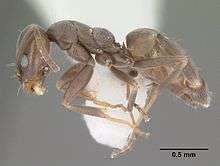Forelius pruinosus
Forelius pruinosus is a species of ant in the genus Forelius. Described by Roger in 1863, the species is endemic to North America.[1]
| Forelius pruinosus | |
|---|---|
 | |
| Forelius pruinosus worker | |
| Scientific classification | |
| Kingdom: | |
| Phylum: | |
| Class: | |
| Order: | |
| Family: | |
| Subfamily: | |
| Genus: | |
| Species: | F. pruinosus |
| Binomial name | |
| Forelius pruinosus (Roger, 1863) | |
| Synonyms | |
| |
Distribution
Forelius pruinosus ants live in the United States, Cuba and Mexico, where they exist in northern portions of the U.S., and their range could possibly extend further into South America.[1] In Mexico, they live in a broad range of habitats and can be found in desert regions, grasslands and various sorts of woodland.[2] They also nest under stones, but they usually prefer to nest in soil instead.[2] Fields, meadows and pastures are ideal habitats for the species, and they will colonise woodland areas that are more open spaced.[3] Methyl-n-amyl ketone chemicals are said to be marked on foraging tracks by these ants.[3] These ants thrive in hot weather and dry conditions, and they are mostly active when it is hot, and will not forage during the night possibly because of cooler temperatures.[2]
Behaviour
Reproductive alates during nuptial flight were recorded from May to August, and colonies of this species are polygyne, which means they have multiple queens, but colonies are usually small to moderately large in size.[2][3] They forage for insects and tends to Hemiptera; they also feed on flower nectar.[2] In the Gulf Coast, these ants are considered a household pest, where they nest in homes and invade houses.[3]
References
- Cuezzo, F. 2000. Revisión del género Forelius (Hymenoptera: Formicidae: Dolichoderinae). Sociobiology 35: 197-275 (page 261, Senior synonym of testaceus)
- Mackay, W. P. and E. Mackay. 2002. The ants of New Mexico (Hymenoptera: Formicidae). Edwin Mellen Press, Lewiston, NY.
- Smith, Marion R. (1965). "House-infesting ants of the eastern United States : their recognition, biology, and economic importance". Technical bulletin no. 1326. Washington, D.C.: United States Department of Agriculture: 72. OCLC 6078460. Retrieved 31 December 2014.